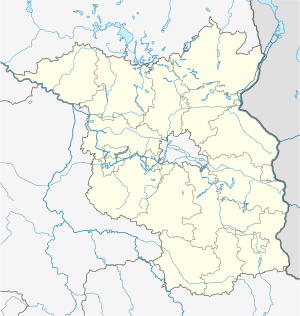Vogelsang power plant
| Vogelsang power plant | |||
|---|---|---|---|
| Power plant ruin in 2008 | |||
| location | |||
|
|
|||
| Coordinates | 52 ° 10 '4 " N , 14 ° 42' 3" E | ||
| country | Germany | ||
| Waters | Or | ||
| Data | |||
| Type | Thermal power plant | ||
| Primary energy | Brown coal | ||
| fuel | Brown coal | ||
| power | 150 MW | ||
| operator | Märkische Elektrizitätswerke | ||
| Project start | April 1, 1943 | ||
| Start of operations | Never been used | ||
| Shutdown | January 31, 1945 | ||
| boiler | 2 × 145 tons of steam / h | ||
| Energy fed in since commissioning | 0 GWh | ||
The Vogelsang power plant is a unitary power plant built towards the end of the Second World War . It never went into regular operation and was dismantled after the war as a reparation payment . The building shell with the two 100 m high chimneys is currently still preserved.
The power plant is the only monument to the industrial boom in Fürstenberg (Oder) . Almost all other certificates have disappeared. Only a few residential buildings of Degussa's industrial area have survived.
history
From 1937 there were plans to settle war-important industries in the small town of Fürstenberg (Oder) . The planning of an IG-Farben factory failed, but in 1940 the construction of a chemical factory for Degussa began. Further settlements followed, armaments factories from Rheinmetall-Borsig and Focke-Wulf joined the existing glass factories.
The location was favorable for a power station. There were several lignite shafts in the area and cooling water could be taken from the Oder. Although there was another high-performance power plant in the vicinity, the Finkenheerd power plant, the available electrical energy was not sufficient for further industrial development. Therefore, the Ministry of Armaments decided to build a unitary power plant as part of the immediate thermal power program near Fürstenberg (Oder) .
construction
On April 1, 1943, power plant construction began by Märkische Elektrizitätswerke . Jewish forced laborers and prisoners of war from the Stalag III B team main camp were used for the construction . A "half-plant" with two machine groups of 75 MW each was built. The name "Kraftwerk Vogelsang" was used from 1944 onwards. The power plant is identical to four other new power plants to be built. The equipment was designed according to the state of the art at the time. In order to save material, the power plant was divided into heavy and lightweight structures. This can still be seen from the existing power plant ruins. The two heavy reinforced concrete structures are still there, the boiler house in between including its steel structure was dismantled.
A test run was carried out on a machine shortly before the construction stop.
End of war
Construction was stopped on January 31, 1945. On February 6th, the Red Army overcame the frozen Oder and built a bridgehead around the power station, which continued fighting until the end of April, with a great number of dead on both sides. At this point the Red Army had already reached Berlin.
Over 400 Red Army soldiers are buried in the cemetery in Vogelsang . The German side had called in all available soldiers. Among other things, the SS recruited 135 young people; after the second attack, 27 were "left". The village of Vogelsang was almost completely destroyed by the fighting.
After the Second World War
Even after the war, the power plant never went into operation. It was dismantled as a reparation payment. It is not known whether and where the facilities have been reinstalled.
Most of the other armaments factories were also dismantled. Many refugees from Neumark and other now Polish areas settled there. Industrial development continued with the construction of a steel mill in 1951.
The power plant site was used as a training area for civil defense and combat groups .
Current condition
The demolition began in 1998 with funds of 2.5 million DM . However, conservationists stopped the demolition by legal means, as the power plant area has now developed into a habitat for threatened bird species and bats.
The power plant site was auctioned off to a Dutch real estate developer for € 8,500 in 2010. It is only barely cordoned off and often serves young people as an object for “ tests of courage ”.
In their essay, Drieschner and Schulz propose to preserve the power plant as a memorial: "The building documents the expansion of the German economy during the total war at the expense of many human lives.", Especially since all other testimonies, including the prisoner of war camp, have not been preserved. So far, however, there are no financially viable concepts that do justice to the functions of a monument and biotope.
The Oder-Neisse cycle path leads directly past the power plant.
Individual evidence
- ^ A b Axel Drieschner, Barbara Schulz: Monument or contaminated site? A power station ruin in Eisenhüttenstadt tells of the arms industry, forced labor and war . March 25, 2002, doi : 10.18452 / 6972 ( hu-berlin.de [accessed on August 2, 2020]).
- ^ Karl Schröder: Kraftwerk Wilhelm . In: Power plant atlas with parameters of 200 power plants, 98 power plant descriptions and 6 exemplary embodiments (= large steam power plants ). Springer, Berlin, Heidelberg 1959, ISBN 978-3-642-52090-7 , pp. 444-449 , doi : 10.1007 / 978-3-642-52090-7_66 .
- ^ "Vogelsang Power Plant" ruins. In: Vogelsang on the Oder. 2013, accessed August 4, 2020 .
- ^ A b Janet Neiser: Life- threatening action: Climbing duo conquers power plant ruins near Fürstenberg. In: Märkische Oderzeitung . June 5, 2020, accessed August 2, 2020 .


